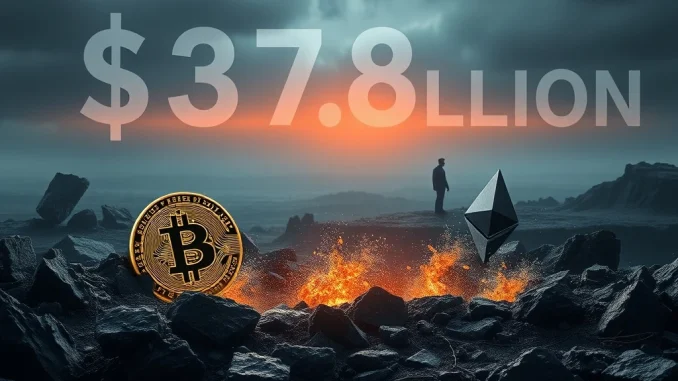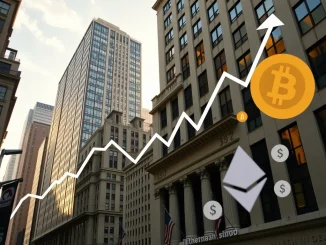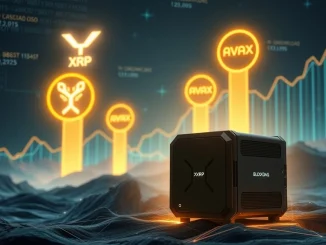
In the unpredictable world of finance, few figures spark as much debate as Jim Cramer. The outspoken host of CNBC’s ‘Mad Money’ has once again captured headlines, this time with a compelling, if controversial, call to action for investors: buy Bitcoin (BTC) and Ethereum (ETH). His rationale? To fortify your financial future against the daunting backdrop of the United States’ escalating $37.8 trillion national debt. This latest endorsement has sent ripples through the cryptocurrency community, prompting both renewed interest and familiar skepticism, especially concerning the concept of ‘Inverse Cramer’.
Jim Cramer’s Bold Stance: Why Bitcoin and Ethereum Now?
During a recent live appearance on CNBC, Jim Cramer didn’t mince words. He passionately urged viewers to consider allocating assets into leading cryptocurrencies, framing them as essential protection against the long-term economic risks associated with an unsustainable national debt. “Get some protection for yourself against the $37.8 trillion debt. Get it for your children, for future generations,” Cramer declared, emphasizing a generational safeguard against fiat currency devaluation. His direct advice – “Buy some Bitcoin, buy some ETH” – underscores a growing, albeit contested, narrative that digital assets can serve as robust hedges against traditional financial instability. This perspective highlights the potential of Bitcoin and Ethereum to act as stores of value in an increasingly uncertain macroeconomic environment.
Cramer’s advocacy for cryptocurrencies as a hedge against the immense US Debt is not entirely new, but the renewed urgency in his tone reflects a broader concern about fiscal responsibility and the future purchasing power of the dollar. The argument posits that decentralized digital assets, with their capped supplies (like Bitcoin) or deflationary mechanisms (like Ethereum post-Merge), offer an alternative to traditional currencies susceptible to inflationary pressures stemming from government spending and debt accumulation.
The Alarming Reality: Understanding the $37.8 Trillion US Debt
The figure Cramer cited – $37.8 trillion – is staggering and represents the cumulative debt owed by the U.S. federal government. This includes public debt held by individuals, corporations, and foreign governments, as well as intragovernmental holdings. Understanding the implications of such a massive debt is crucial for any investor:
- Inflationary Pressure: To manage or reduce the real value of debt, governments might resort to printing more money, which can devalue the currency and lead to inflation. This erodes the purchasing power of savings and fixed incomes.
- Higher Interest Rates: A larger debt can lead to higher interest rates as the government competes with private borrowers for capital. This increases borrowing costs for businesses and consumers, potentially slowing economic growth.
- Intergenerational Burden: As Cramer highlighted, the debt represents a future burden on younger generations, who will bear the responsibility of paying it back through taxes or face reduced government services.
- Economic Instability: Excessive debt can lead to a loss of confidence in a nation’s fiscal health, potentially triggering economic crises or reducing its global influence.
It’s within this context that the argument for assets like Bitcoin and Ethereum as a hedge gains traction. Their decentralized nature means they are not directly controlled by any single government or central bank, theoretically making them immune to the inflationary policies that might accompany efforts to manage national debt.
The ‘Inverse Cramer’ Phenomenon: A Double-Edged Sword for Crypto Investment?
Perhaps as notable as Cramer’s endorsement itself is the immediate resurgence of the term “Inverse Cramer” within crypto circles. This phenomenon refers to a long-standing, tongue-in-cheek observation that assets publicly recommended by Cramer tend to underperform or decline shortly thereafter. While purely anecdotal and not a guaranteed outcome, it’s a dynamic that adds a layer of skepticism to his high-profile commentary.
The irony is not lost on the market, especially given Cramer’s disclosure during his remarks that he had previously sold all his Ethereum holdings and refrained from further commentary on the crypto market before this latest pivot. This shift in stance has fueled speculation about his current position and the true conviction behind his new endorsement. For many seasoned crypto investors, Cramer’s statements often serve as a contrarian indicator, prompting them to either reconsider their positions or, humorously, to do the opposite of what he suggests.
However, dismissing Cramer’s influence entirely would be short-sighted. His reach in traditional finance (TradFi) is undeniable. When a figure of his stature advocates for Bitcoin and Ethereum, it signals a gradual but significant shift in perception among mainstream investors. It brings cryptocurrencies into conversations they might not otherwise have, pushing them further into the public consciousness as legitimate assets, even if the immediate market reaction is mixed.
Bitcoin and Ethereum as Generational Safeguards: Fact or Fiction?
Cramer’s call to buy Bitcoin and Ethereum as a generational safeguard taps into a core narrative of the crypto community: that these digital assets offer a superior, sound money alternative to fiat currencies. The argument rests on several pillars:
- Scarcity: Bitcoin has a hard cap of 21 million coins, making it inherently scarce, similar to gold. Ethereum, after its transition to Proof-of-Stake, has seen periods of deflationary supply, where more ETH is burned than issued.
- Decentralization: Neither Bitcoin nor Ethereum is controlled by a central authority, making them resistant to censorship, manipulation, or arbitrary monetary policy changes by governments.
- Global Accessibility: Cryptocurrencies are borderless, allowing for value transfer and storage without reliance on traditional banking systems, which can be particularly appealing in regions with unstable economies.
While these attributes make a compelling case for long-term crypto investment, it’s vital to acknowledge the inherent volatility and regulatory uncertainties that still plague the sector. Bitcoin and Ethereum, despite their growing maturity, are still relatively nascent assets compared to traditional financial instruments. Investors considering them as long-term hedges must be prepared for significant price swings and evolving regulatory landscapes.
Navigating Your Crypto Investment Journey: Actionable Insights
Jim Cramer’s commentary, regardless of its perceived predictive power, serves as a powerful reminder for all investors: do your own research (DYOR). In a market as dynamic and rapidly evolving as cryptocurrency, relying solely on any single expert’s opinion, no matter how influential, can be perilous. Here are some actionable insights for navigating your crypto investment journey:
- Diversify Your Portfolio: While Bitcoin and Ethereum are dominant, consider a diversified approach that includes a mix of traditional assets and a carefully considered allocation to crypto that aligns with your risk tolerance.
- Understand the Technology: Don’t just buy because someone famous said so. Learn about the underlying technology, use cases, and economic models of Bitcoin, Ethereum, and any other crypto asset you consider.
- Assess Risk: Cryptocurrencies are highly volatile. Invest only what you can afford to lose. Understand the potential for both significant gains and substantial losses.
- Stay Informed: Follow reputable news sources, engage with knowledgeable communities, and keep abreast of regulatory developments and technological advancements in the crypto space.
- Long-Term vs. Short-Term: Decide if your crypto investment is for short-term gains or a long-term hedge. Your strategy will dictate your approach to market fluctuations.
The tension between traditional finance (TradFi) and crypto-native actors remains a defining characteristic of the market. Cramer’s appeal to “future generations” reflects a narrative often used to justify long-term crypto adoption, yet his history of selling key holdings complicates this message. This highlights the need for investors to critically evaluate all expert opinions, especially in a sector as volatile and innovative as crypto.
Conclusion: Beyond the Headlines, A Critical Look at Crypto’s Role
Jim Cramer’s latest call to buy Bitcoin and Ethereum as a defense against the spiraling $37.8 trillion US debt has certainly ignited discussion. While his track record invites the humorous ‘Inverse Cramer’ label, his willingness to advocate for cryptocurrencies on a mainstream platform underscores their growing recognition as potentially viable assets in a diversified portfolio. Whether you view his advice as a golden opportunity or a contrarian signal, the underlying message remains crucial: the macroeconomic landscape is shifting, and traditional financial hedges may not be sufficient for future generations.
Ultimately, the decision to engage in crypto investment, whether in Bitcoin, Ethereum, or other digital assets, should be rooted in thorough research, a clear understanding of personal risk tolerance, and a long-term perspective. The conversation around national debt and alternative assets will only intensify, making informed decision-making more critical than ever.
Frequently Asked Questions (FAQs)
Q1: Why did Jim Cramer recommend Bitcoin and Ethereum now?
A1: Jim Cramer recommended Bitcoin and Ethereum as a hedge against the rising U.S. national debt, which he cited as $37.8 trillion. He believes these cryptocurrencies can offer protection for current and future generations against potential inflation and fiat currency devaluation caused by unsustainable debt levels.
Q2: What is the ‘Inverse Cramer’ phenomenon?
A2: The ‘Inverse Cramer’ phenomenon is a humorous observation in financial circles that suggests assets publicly endorsed by Jim Cramer often see price declines shortly after his recommendation. While not a rule, it’s a common topic of discussion and skepticism among investors.
Q3: How can Bitcoin and Ethereum act as a hedge against national debt?
A3: Bitcoin and Ethereum are often considered hedges due to their decentralized nature and scarcity. Bitcoin has a fixed supply (21 million coins), and Ethereum has become deflationary at times, making them resistant to the inflationary pressures that can result from governments printing more money to manage large national debts. They offer an alternative store of value outside traditional financial systems.
Q4: Should I follow Jim Cramer’s crypto investment advice?
A4: While Jim Cramer is an influential figure, it’s crucial for investors to conduct their own thorough research (DYOR) before making any investment decisions, especially in volatile markets like cryptocurrency. His track record has been mixed, and the ‘Inverse Cramer’ effect is a popular notion. Always consider your own financial situation and risk tolerance.
Q5: What are the risks associated with investing in Bitcoin and Ethereum?
A5: The primary risks include high price volatility, regulatory uncertainty, potential for market manipulation, and technological risks. While they offer potential for significant returns, they also carry the risk of substantial losses. It’s important to understand these risks before engaging in crypto investment.



